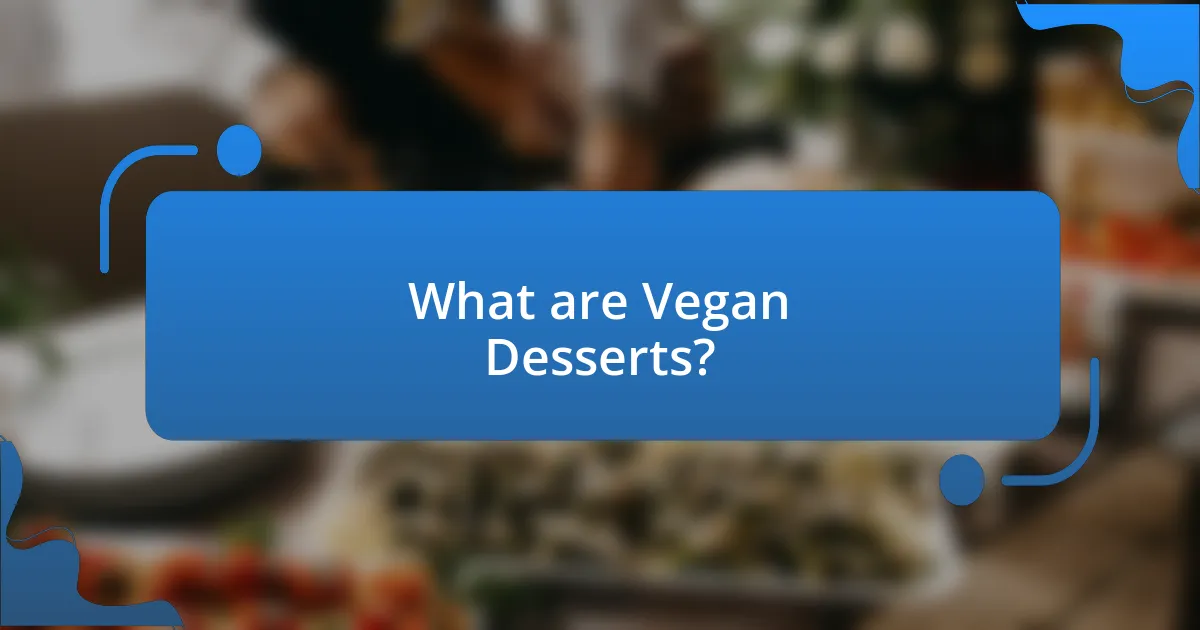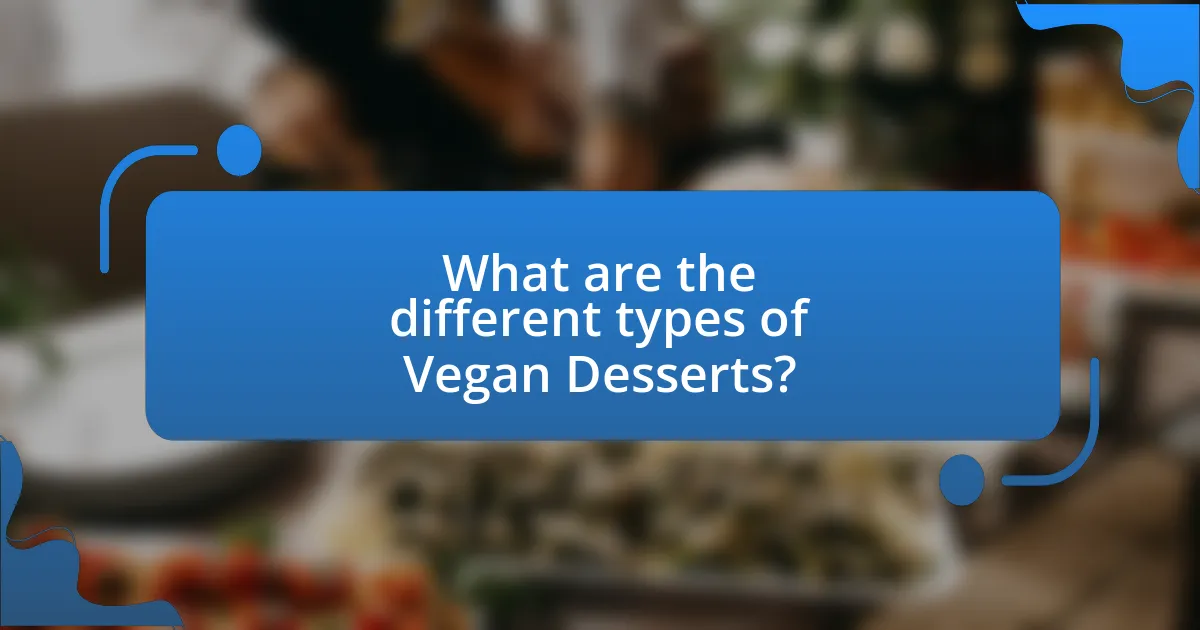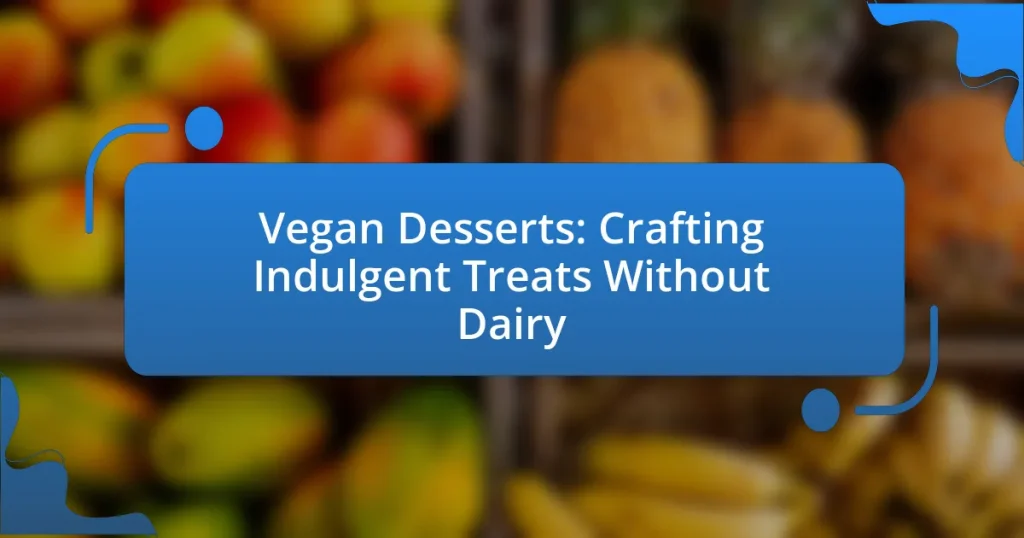Vegan desserts are sweet treats crafted without any animal-derived ingredients, utilizing plant-based alternatives such as fruits, nuts, and non-dairy milk to achieve desired flavors and textures. This article explores the differences between vegan and traditional desserts, highlighting common ingredients and the health benefits associated with a vegan diet. It also discusses the ethical and environmental considerations of choosing vegan desserts, categorizes various types, and provides practical tips for creating indulgent vegan treats at home. Additionally, popular recipes and troubleshooting advice for baking vegan desserts are included, making it a comprehensive guide for anyone interested in this growing culinary trend.

What are Vegan Desserts?
Vegan desserts are sweet treats made without any animal-derived ingredients, including dairy, eggs, or honey. These desserts utilize plant-based alternatives such as fruits, nuts, seeds, and non-dairy milk to achieve flavor and texture. For example, coconut milk can replace cream, while flaxseed or chia seeds can serve as egg substitutes in baking. The growing popularity of veganism has led to an increase in the variety and availability of vegan desserts, making them accessible to a wider audience.
How do Vegan Desserts differ from traditional desserts?
Vegan desserts differ from traditional desserts primarily in their ingredients, as vegan desserts do not contain any animal products, including dairy and eggs. Traditional desserts often rely on these ingredients for texture, flavor, and moisture, while vegan desserts utilize plant-based alternatives such as almond milk, coconut cream, or flaxseed to achieve similar results. For instance, a traditional chocolate cake typically includes eggs for binding and dairy for richness, whereas a vegan chocolate cake may use applesauce or aquafaba as substitutes, allowing it to remain free from animal-derived components. This fundamental difference in ingredients not only caters to dietary restrictions but also aligns with ethical and environmental considerations associated with veganism.
What ingredients are commonly used in Vegan Desserts?
Common ingredients used in vegan desserts include plant-based alternatives such as almond milk, coconut milk, and cashew cream, which replace dairy products. Additionally, ingredients like flaxseed meal or chia seeds serve as egg substitutes, while natural sweeteners such as maple syrup, agave nectar, and coconut sugar provide sweetness without animal products. Other common components include whole grains like oats and flour, fruits for flavor and moisture, and nuts or nut butters for richness and texture. These ingredients collectively enable the creation of indulgent desserts that align with vegan dietary practices.
How do Vegan Desserts achieve similar textures and flavors?
Vegan desserts achieve similar textures and flavors to traditional desserts through the use of plant-based ingredients that mimic the properties of dairy and eggs. Ingredients such as coconut cream, nut butters, and aquafaba (the liquid from canned chickpeas) provide creaminess and structure, while natural sweeteners like maple syrup and agave nectar enhance flavor profiles. For example, aquafaba can be whipped to create a light, airy texture similar to egg whites in meringues, and coconut cream can replicate the richness of heavy cream in frostings and ganaches. These substitutions allow vegan desserts to maintain the desired mouthfeel and taste, making them appealing alternatives to their non-vegan counterparts.
Why choose Vegan Desserts?
Vegan desserts are chosen for their health benefits, ethical considerations, and environmental impact. These desserts typically contain no animal products, making them suitable for those with lactose intolerance or dairy allergies. Research indicates that plant-based diets can lower the risk of chronic diseases, such as heart disease and diabetes, due to their higher fiber content and lower saturated fat levels. Additionally, choosing vegan desserts aligns with ethical choices regarding animal welfare and reduces the carbon footprint associated with dairy production, which contributes significantly to greenhouse gas emissions.
What health benefits are associated with Vegan Desserts?
Vegan desserts offer several health benefits, primarily due to their plant-based ingredients. These desserts are typically lower in saturated fats and cholesterol-free, which can contribute to improved heart health. For instance, a study published in the Journal of the American College of Cardiology found that plant-based diets are associated with a reduced risk of heart disease. Additionally, vegan desserts often contain higher amounts of fiber, vitamins, and antioxidants from fruits, nuts, and whole grains, which can enhance digestive health and support the immune system. Furthermore, the absence of dairy can benefit individuals with lactose intolerance or dairy allergies, allowing them to enjoy sweet treats without adverse effects.
How do Vegan Desserts align with ethical and environmental considerations?
Vegan desserts align with ethical and environmental considerations by eliminating animal products, which reduces animal suffering and promotes animal welfare. The production of dairy and eggs is associated with significant ethical concerns, including the treatment of animals in factory farming. Additionally, vegan desserts typically have a lower environmental impact; for instance, a study published in the journal “Nature” found that plant-based diets can reduce greenhouse gas emissions by up to 70% compared to diets high in animal products. This reduction is due to lower resource consumption, such as water and land, required for plant-based ingredients compared to animal farming. Thus, vegan desserts contribute positively to both ethical standards and environmental sustainability.

What are the different types of Vegan Desserts?
Vegan desserts encompass a variety of types, including cakes, cookies, brownies, puddings, ice creams, and mousses. These desserts utilize plant-based ingredients such as fruits, nuts, seeds, and alternative sweeteners instead of dairy and eggs. For example, vegan cakes often use applesauce or flaxseed meal as egg substitutes, while coconut milk or almond milk can replace dairy in puddings and ice creams. The growing popularity of veganism has led to an increase in innovative recipes and products, making vegan desserts accessible and appealing to a wider audience.
How can you categorize Vegan Desserts?
Vegan desserts can be categorized into several distinct types based on their ingredients and preparation methods. These categories include fruit-based desserts, nut-based desserts, grain-based desserts, and frozen desserts. For instance, fruit-based desserts often utilize ingredients like bananas or avocados to create creamy textures, while nut-based desserts may incorporate almond flour or cashews for richness. Grain-based desserts typically use oats or rice flour, and frozen desserts include options like sorbets or vegan ice creams made from coconut milk. This categorization is supported by the diverse range of recipes available in vegan culinary literature, which highlights the versatility and creativity in crafting indulgent treats without dairy.
What are some popular types of Vegan Cakes?
Some popular types of vegan cakes include chocolate vegan cake, carrot vegan cake, and lemon vegan cake. Chocolate vegan cake often utilizes cocoa powder and plant-based milk to achieve a rich flavor, while carrot vegan cake incorporates grated carrots and spices for a moist texture. Lemon vegan cake typically features lemon juice and zest, providing a refreshing taste. These cakes are widely enjoyed for their deliciousness and the ability to cater to those following a vegan diet.
What makes Vegan Ice Cream unique?
Vegan ice cream is unique primarily because it is made without any dairy products, utilizing plant-based ingredients such as almond milk, coconut milk, or cashew cream instead. This dairy-free composition allows it to cater to individuals with lactose intolerance or those following a vegan lifestyle. Additionally, vegan ice cream often incorporates natural sweeteners and flavorings, which can enhance its appeal and health profile. According to a study published in the Journal of Food Science, plant-based ice creams can provide similar textures and flavors to traditional ice creams while offering lower saturated fat content, making them a healthier alternative.
What are some common ingredients in Vegan Desserts?
Common ingredients in vegan desserts include plant-based alternatives such as almond milk, coconut milk, and cashew cream, which replace dairy products. Additionally, ingredients like aquafaba (the liquid from canned chickpeas) serve as an egg substitute, while natural sweeteners like maple syrup and agave nectar provide sweetness without refined sugar. Other frequent components are whole grains, such as oats and flour made from nuts or legumes, along with fruits like bananas and apples that add moisture and flavor. These ingredients collectively enable the creation of indulgent treats that align with a vegan lifestyle.
How do plant-based milks contribute to Vegan Desserts?
Plant-based milks enhance vegan desserts by providing a creamy texture and rich flavor without dairy. These alternatives, such as almond, soy, and oat milk, serve as effective substitutes for traditional milk, allowing for the creation of various desserts like cakes, puddings, and ice creams. For instance, almond milk contains healthy fats and a subtle sweetness, making it ideal for baking, while coconut milk adds a rich, tropical flavor that complements many dessert recipes. Additionally, plant-based milks are often fortified with vitamins and minerals, contributing nutritional value to vegan desserts.
What role do natural sweeteners play in Vegan baking?
Natural sweeteners serve as essential ingredients in vegan baking by providing sweetness and enhancing flavor without the use of animal-derived products. These sweeteners, such as maple syrup, agave nectar, and coconut sugar, not only contribute to the overall taste profile but also offer varying degrees of moisture and texture to baked goods. For instance, maple syrup adds a distinct flavor and moisture, which can improve the texture of cakes and cookies. Additionally, many natural sweeteners have lower glycemic indices compared to refined sugars, making them a healthier alternative for those seeking to manage blood sugar levels.

How can you create indulgent Vegan Desserts at home?
To create indulgent vegan desserts at home, utilize plant-based ingredients such as coconut cream, almond milk, and aquafaba to replicate the textures and flavors of traditional desserts. For instance, coconut cream can be whipped to create a rich frosting, while almond milk serves as a versatile base for puddings and cakes. Incorporating natural sweeteners like maple syrup or agave nectar enhances sweetness without refined sugars. Additionally, using ingredients like dark chocolate (which is often dairy-free) and nut butters can add depth and richness to desserts. Studies show that vegan desserts can be just as satisfying as their non-vegan counterparts, proving that indulgence does not require dairy.
What are some essential tips for baking Vegan Desserts?
To successfully bake vegan desserts, use plant-based substitutes for eggs and dairy, such as flaxseed meal or applesauce for binding and coconut milk or almond milk for creaminess. These alternatives maintain the texture and moisture of traditional desserts. For instance, flaxseed meal mixed with water can replace one egg, providing similar binding properties. Additionally, incorporating ingredients like nut butters or silken tofu can enhance richness and flavor. Using high-quality cocoa powder and natural sweeteners like maple syrup or agave nectar can also improve taste while keeping the dessert vegan.
How can you substitute dairy ingredients in traditional recipes?
To substitute dairy ingredients in traditional recipes, use plant-based alternatives such as almond milk, coconut cream, or cashew cheese. Almond milk can replace cow’s milk in a 1:1 ratio, providing a similar texture and flavor. Coconut cream serves as an excellent substitute for heavy cream, offering richness and creaminess, while cashew cheese can mimic the taste and texture of cream cheese in recipes. These alternatives are widely available and have been shown to maintain the integrity of traditional recipes while catering to vegan dietary preferences.
What tools and equipment are helpful for making Vegan Desserts?
Essential tools and equipment for making vegan desserts include a high-speed blender, food processor, measuring cups and spoons, mixing bowls, and baking pans. A high-speed blender is crucial for creating smooth textures in items like vegan creams and sauces, while a food processor aids in mixing and chopping ingredients efficiently. Accurate measuring cups and spoons ensure precise ingredient ratios, which is vital for successful baking. Mixing bowls are necessary for combining ingredients, and various baking pans are required for different dessert types, such as cakes, brownies, or cookies. These tools collectively facilitate the preparation and baking processes, ensuring that vegan desserts are crafted effectively and with desirable results.
What are some popular Vegan Dessert recipes to try?
Popular vegan dessert recipes to try include chocolate avocado mousse, coconut milk ice cream, and banana oat cookies. Chocolate avocado mousse combines ripe avocados with cocoa powder and sweeteners, creating a creamy, rich dessert that is dairy-free. Coconut milk ice cream utilizes coconut milk as a base, allowing for a creamy texture without dairy, and can be flavored with various fruits or extracts. Banana oat cookies are made with mashed bananas and oats, providing a simple, healthy treat that is naturally sweetened and vegan-friendly. These recipes are widely appreciated for their taste and ease of preparation, making them excellent choices for anyone exploring vegan desserts.
How do you make a Vegan Chocolate Cake?
To make a Vegan Chocolate Cake, combine flour, cocoa powder, baking soda, and salt in a bowl. In a separate bowl, mix plant-based milk, vegetable oil, apple cider vinegar, and vanilla extract. Gradually add the wet ingredients to the dry ingredients, stirring until just combined. Pour the batter into a greased cake pan and bake at 350°F (175°C) for 30-35 minutes. This method is effective as it utilizes common vegan substitutes that maintain moisture and flavor, ensuring a rich chocolate taste without dairy.
What is the process for creating Vegan Cheesecake?
The process for creating Vegan Cheesecake involves blending a base of soaked cashews, plant-based milk, and sweeteners, then pouring the mixture over a crust made from crushed nuts and dates. First, soak raw cashews in water for several hours to soften them, which allows for a creamy texture when blended. Next, combine the soaked cashews with ingredients such as coconut milk, maple syrup, and lemon juice in a blender until smooth. For the crust, blend dates and nuts until crumbly, then press the mixture into the bottom of a springform pan. Finally, pour the cheesecake filling over the crust and refrigerate for several hours until set. This method ensures a rich and creamy vegan dessert that mimics traditional cheesecake without using dairy.
What troubleshooting tips can help with Vegan Dessert preparation?
To troubleshoot vegan dessert preparation, ensure you use the right substitutes for eggs and dairy, as these are crucial for texture and moisture. For instance, flaxseed meal or chia seeds mixed with water can effectively replace eggs, providing binding properties. If a dessert is too dry, consider adding more liquid ingredients like plant-based milk or applesauce to enhance moisture. Conversely, if the dessert is too wet, increase the dry ingredients proportionately. Additionally, monitor baking times closely, as vegan desserts may require adjustments compared to traditional recipes; for example, they often bake faster due to the absence of dairy fats. Lastly, if a dessert lacks flavor, enhance it with natural extracts like vanilla or almond, or incorporate spices such as cinnamon or nutmeg to elevate the taste profile.
How can you prevent common baking issues in Vegan Desserts?
To prevent common baking issues in vegan desserts, use appropriate substitutes for eggs and dairy, as these ingredients play crucial roles in texture and moisture. For instance, flaxseed meal or chia seeds can replace eggs, providing binding properties, while plant-based milks and oils can maintain moisture levels. Additionally, ensure accurate measurements of ingredients, as vegan baking often requires precise ratios to achieve the desired consistency. Overmixing can lead to dense textures, so mix just until combined. Lastly, monitor baking times closely, as vegan desserts may bake faster than traditional ones due to the absence of dairy fats.
What adjustments should be made for high-altitude baking of Vegan Desserts?
For high-altitude baking of vegan desserts, reduce the amount of baking powder or baking soda by 1/4 to 1/2, as the lower air pressure can cause baked goods to rise too quickly and then collapse. Additionally, increase the liquid content by 1 to 2 tablespoons per cup to counteract the drier air, which can lead to dryness in the final product. Furthermore, consider increasing the oven temperature by 15 to 25 degrees Fahrenheit to help set the structure of the dessert more quickly. These adjustments are necessary because at elevations above 3,000 feet, the boiling point of water decreases, affecting the baking process and moisture retention.


